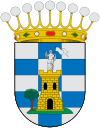Oropesa (Toledo)
| Oropesa municipality | ||
|---|---|---|
 Oropesa - church, castle (castillo) and palace (palacio)
|
||
| coat of arms | Map of Spain | |

|
|
|
| Basic data | ||
| Autonomous Community : | Castile-La Mancha | |
| Province : | Toledo | |
| Comarca : | Campana de Oropesa | |
| Coordinates | 39 ° 55 ′ N , 5 ° 11 ′ W | |
| Height : | 423 msnm | |
| Area : | 336.56 km² | |
| Residents : | 2,662 (Jan 1, 2019) | |
| Population density : | 7.91 inhabitants / km² | |
| Postal code : | 45560 | |
| Municipality number ( INE ): | 45125 | |
| administration | ||
| Website : | Oropesa | |
Oropesa is a small town and a central Spanish municipality with 2,662 inhabitants (as of January 1, 2019) in the province of Toledo in the Castile-La Mancha region . The historic town center is recognized as a national cultural asset ( Bien de Interés Cultural ) in the Conjunto histórico-artístico category .
Location and climate
The small town of Oropesa lies at the foot of the Sierra de Gredos in the west of the historical landscape of La Mancha approx. 118 km (driving distance) west of the city of Toledo at an altitude of approx. 425 m ; the likewise historically significant town of Talavera de la Reina is only about 40 km to the east. The climate in winter is harsh, but in summer it is dry and warm; the sparse rain (approx. 380 mm / year) falls mainly in the winter months.
Population development
| year | 1857 | 1900 | 1950 | 2000 | 2017 |
| Residents | 2,230 | 2,817 | 4,578 | 2,717 | 2,730 |
The mechanization of agriculture , which has been increasing since the 1950s, and the abandonment of small farms led to a decline in purchasing power and the emigration of part of the population in the small town as well.
economy
The small town is located on an old trade route along the Río Tajo . The area around Oropesa was and is essentially agricultural; the people lived largely as self-sufficient . The city itself served as a craft and mercantile center for the surrounding villages. Day tourism has been of greater importance since the 1960s.
history
Celtic , Roman and Visigoth finds have not yet been made. However, the Moors built a fortress of which remains are still preserved. After the successful reconquest ( reconquista ) in 1085 by the Christians under the leadership of the Leonese-Castilian king Alfonso VI. the area was repopulated ( repoblación ) . The place is mentioned for the first time in a document from 1277. In 1366, Henry II handed over the city and its surroundings to García Álvarez de Toledo , the 1st Duke of Alba , in recognition of his loyal service , whose family built the current castle around 1400. The Catholic kings Isabella I and Ferdinand II turned the mere manor (señorio) into a county (condado) in 1475 .
Attractions
- Immediately adjacent to an older Moorish fortress erected a member of the house Álvarez de Toledo in 1402 today's castle (castillo) with their dominant keep (Torre del homenaje) of granite . Around the middle of the 16th century, the neighboring palace (palacio) , which has been used as a Parador since 1930 , was commissioned by Francisco Álvarez de Toledo (1515–1582), Duke of Alba and Count of Oropesa .
- The Iglesia de Nuestra Señora de la Asunción , with a single nave but with a transept , is dedicated to the Assumption of Mary and was also largely made of granite in the 16th century not far from the castle. Particularly noteworthy are the Renaissance portal in the lower zone of the bell tower and the polygonal broken apse with its cassette-like dome vault .
- The Jesuit College (Colegio de los Jesuitas) was founded around 1600; its planning is still attributed to the Escorial architect Juan de Herrera († 1597).
- The unstructured strict house facade of the otherwise Mudéjar-style church of San Bernardo is attributed to the architect Francisco de Mora († 1610).
- The old town hall (ayuntamiento) with its exceptionally richly designed portal was formerly an aristocratic palace.
- The clock tower in Plaza del Navarro was built in 1901.
Personalities
- Juan de Castilla (also Juan de Haro ) (1264-1319), Infante of Castile, landlord (señor) of Oropesa etc., Alférez Mayor of Castile
- Fernando de Valencia (1316–1384), Señor de Valencia de Campos, Oropesa etc.
- Bernardino Vázquez de Tapia (1490 – around 1552), conquistador and author
- Rodrigo Orgóñez (1490–1538), Conquistador
- Alfonso von Orozco (1500–1591), monk and preacher, saint
- Francisco Álvarez de Toledo (1515–1582), Duke of Alba and Count of Oropesa, Viceroy of Peru
Web links
- Oropesa, history and monuments - photos + info (Spanish)
- Oropesa, history and attractions - photos + quick facts (spanish)
Individual evidence
- ↑ Cifras oficiales de población resultantes de la revisión del Padrón municipal a 1 de enero . Population statistics from the Instituto Nacional de Estadística (population update).
- ↑ Oropesa - Climate tables
- ↑ Oropesa - population development
- ^ Oropesa story
- ↑ Parador de Oropesa. parador.es, accessed on May 16, 2020 .






